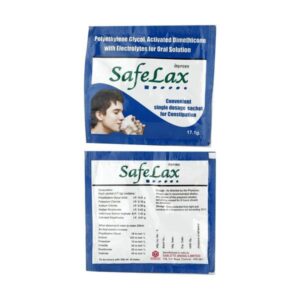ACTIVATED DIMETHICONE + POLYETHYLENE GLYCOL
Activated Dimethicone: Activated Dimethicone is a medication used to relieve symptoms of excess gas in the gastrointestinal tract. It is commonly used to treat conditions such as bloating, flatulence, and discomfort caused by gas accumulation.
The mechanism of action of Activated Dimethicone involves the physical alteration of gas bubbles in the stomach and intestines. It works by breaking down the surface tension of gas bubbles, causing them to merge and form larger bubbles. These larger bubbles are easier to pass through the digestive system, providing relief from symptoms of gas.
Activated Dimethicone is available in chewable tablet or liquid form. The typical recommended dose for adults is 40-125mg, to be taken orally after meals and at bedtime, or as directed by a healthcare professional. For children, the appropriate dose should be determined by a pediatrician based on the child’s age and weight.
Although Activated Dimethicone is generally well-tolerated, some side effects may occur. These side effects are usually mild and include diarrhea, constipation, and stomach discomfort. If any of these side effects persist or worsen, it is important to consult a healthcare professional.
It is important to note that Activated Dimethicone is not intended to treat or manage underlying conditions that may be causing excess gas, such as gastrointestinal disorders. It should only be used for symptomatic relief of gas-related symptoms. It is always advisable to consult a healthcare professional before starting any new medication to determine the appropriate use and dosage.
Polyethylene Glycol: Polyethylene Glycol (PEG) is a medication commonly used as a laxative to relieve constipation. It works by increasing the water content in the stool, making it softer and easier to pass.
The drug is available as an over-the-counter product and also in prescription strength formulations. It is typically taken orally, with the dosage varying depending on the specific product and the severity of the constipation.
The most common side effects of PEG include bloating, cramping, diarrhea, nausea, and excessive gas. These symptoms are usually mild and temporary. However, severe abdominal pain, persistent diarrhea, or rectal bleeding should be reported to a healthcare professional immediately.
PEG is generally safe for short-term use. However, prolonged or excessive use can lead to electrolyte imbalances, dehydration, or damage to the gastrointestinal tract. It is important to follow the recommended dosage and duration of treatment as directed by a healthcare provider.
In some cases, PEG may not be suitable for individuals with certain medical conditions such as bowel obstruction or perforation, gastric retention, or hypersensitivity to the drug. It is always best to consult with a healthcare professional before starting any new medication, including PEG.
In summary, Polyethylene Glycol is a laxative used to relieve constipation by increasing stool water content. It is available as an over-the-counter or prescription medication and is generally safe when used as directed. Common side effects include bloating, cramping, and diarrhea. However, severe symptoms should be reported to a healthcare professional.

